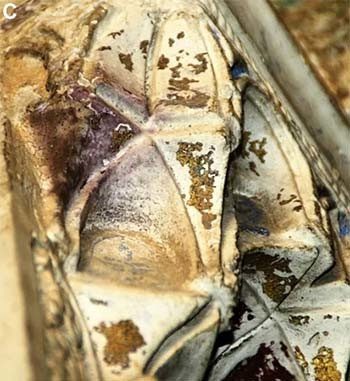The appearance of purple on the gold decorative details of the famous Alhambra Palace stems from complex chemical reactions.

A section of the gold ceiling of the Alhambra Palace. (Photo: Radiokafka)
The Alhambra Palace in Granada, Spain, is considered one of the finest examples of Islamic architecture in the world. Construction began in 1238, but the palace has been modified and expanded multiple times, particularly in the 14th century. Many areas of the ceiling are covered with thin sheets of gold, but over time, some spots have developed unusual purple patches.
Professor Carolina Cardell and Dr. Isabel Guerra at the University of Granada have studied this phenomenon and discovered it arises from a series of chemical reactions that convert gold into nanoparticles, IFL Science reported on September 14. The new research was published in the journal Science Advances.
The emergence of purple patches has puzzled observers because pure gold is a metal that reacts very little in natural and industrial environments. Gold does not tarnish under sunlight or change in ordinary environmental conditions such as humidity, air pollution, corrosive gases, and high temperatures.
The decorative details of the Alhambra are not made of solid gold, as that would be impractical and expensive, and difficult to protect from thieves over the centuries. Instead, they are made of tin and coated with a thin layer of gold.

Damaged gold-plated tin with purple patches. (Photo: Cardell and Guerra/Science Advances)
A study in 2006 indicated that purple only appeared in damp areas, but did not explain why. In the new study, Cardell and Guerra used a field emission scanning electron microscope (FESEM) with high resolution to examine the purple patches and compare them with areas that retained their original gold color.
With sizes measured in nanometers, gold nanoparticles exhibit different properties compared to bulk material. In fact, one can obtain most rainbow colors from suspended gold nanoparticles in water merely by altering their size and shape. With sizes similar to the wavelengths of visible light, the particles absorb certain photons, reflecting longer and shorter photons that the human eye perceives.
The research team found that exposure to chlorine-rich water decomposed gold into nanoparticles approximately 70 nanometers wide—an ideal size for reflecting the purple portion of the spectrum while absorbing most other visible light. Additionally, the decomposition of gold into nanoparticles is also influenced by the porosity of the gold leaf and its adhesion to the underlying tin layer.
In addition to unraveling a long-standing mystery, the scientists hope that their new research will assist conservators in better preventing the erosion of historical monuments.


















































